You’ll often hear golfers talking about the sweet spot; the exact location on the club face that must make contact with the ball in order to pull off the perfect shot. Well there is a sweet spot in bowls too, but it’s to do with greenkeeping and not the playing of the sport.
Bowling greens are little eco-systems all of their own, and that includes billions of different organisms, the soil, the grass plants and the surroundings. All of the sciences are involved in this and when the Physics, Chemistry and Biology of our little bowling green eco-system are in perfect balance, the fine perennial grasses will naturally dominate the sward. In addition to this, turf diseases, weeds and other disorders will be absent, thatch will be minimal, meaning that the green surface will perform at a high level, consistently and predictably. The green will have good pace, it will be smooth and it will run true. In fact we will have hit the sweet spot in greenkeeping terms.
Hitting the Sweet Spot
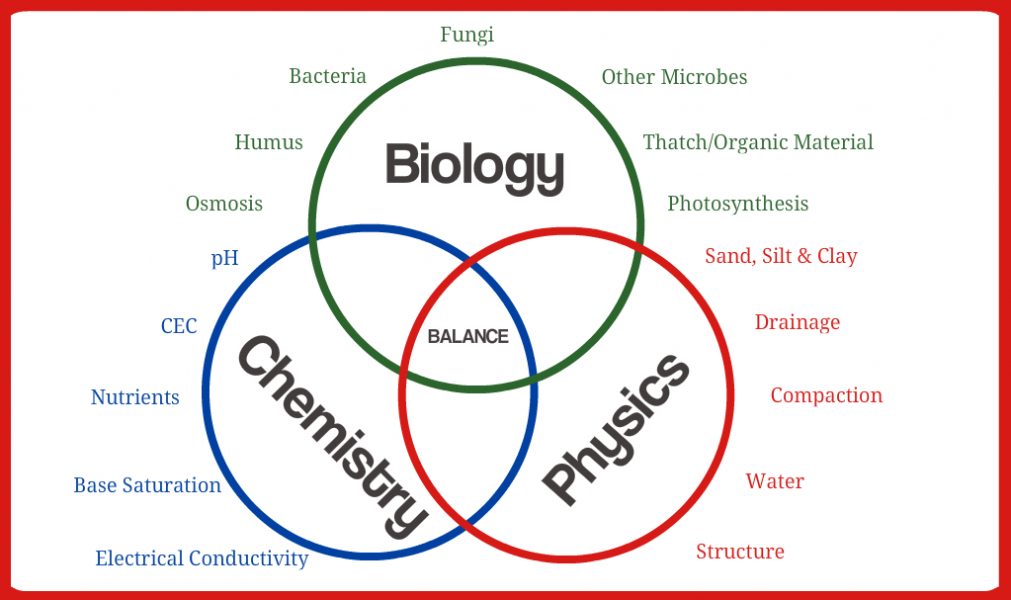
The Sweet Spot in Bowling Green Maintenance is represented by the little guitar pick shaped intersection in the centre of the diagram above. This shows a green with its Soil Chemistry, Physics and Biology in perfect balance, but what does that mean in practice?
Soil Chemistry
The items of interest in the soil’s chemistry are largely concerned with the relative availability of nutrients (essential elements). Key influences here are Electrical Conductivity, which tells us how salty the soil is. The concentration of mineral salts in the soil can build up to a level that is detrimental to plant health. A high concentration of mineral salts in the soil can cause the process of Osmosis in the plant to slow or in severe cases even go into reverse, effectively sucking moisture back out of the plant roots.
Soil pH is another key factor in soil chemistry. For the fine grasses (Bent and Fescue) we aim to grow, the optimum soil pH is somewhere between 5.5 and 6.5, slightly acid. When it is above or below this, then many key elements are locked up in the soil and unavailable.
The Base Saturation of Cations (positively charged nutrient ions) is the next thing to consider here, the ideal situation would see Calcium (Ca) making up the bulk of the exchange sites on the soil colloid (a collective term representing the total clay and humus in the soil) with Magnesium (Mg), Potassium (K), Sodium(Na) and others taking up the remaining space.
The ratio of Ca : K : Mg when measured in parts per million (ppm) should be about 7-10 : 2 : 1 producing Base Saturation percentages of approximately 60-70% Calcium, 3-10% Magnesium, 2-5% Potassium, 0 – 2% Sodium. In most bowls and golf green rootzones the remainder are hydrogen (H) 10-15% and other cations (2-5%) providing a pH of 5.5 – 6.5. In an ideal situation the Base Saturation would look like this:
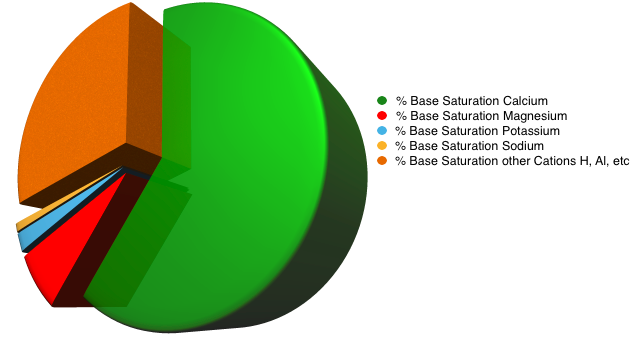
All this talk of Cations brings us neatly to Cation Exchange Capacity or CEC, which is a key measure of your soil’s chemistry.
Cation Exchange Capacity (CEC) measures the number of negatively charged sites there are in the soil for positive cations to bind to. This helps to hold nutrition in the soil and prevents nutrients from leaching out through the drains. These positive Cations include Calcium (Ca), Potassium (K), Magnesium (Mg), Sodium (Na), and of course Hydrogen (H). A higher CEC means that more nutrients can be held within the root zone without the risk of leaching out through the drains.
If the Base Saturation is close to ideal then the soil pH will usually be within range, but CEC could still be out of kilter. Very sandy rootzones tend to have a low CEC, which brings us neatly to Soil Physics.
Soil Physics
The Physical condition of your green’s rootzone/soil has far reaching effects. As we have seen already, one of those is that it can affect the soil’s ability to provide Nutrients to the plants, but it goes a lot further than that.
The ideal soil for producing a high performance bowling green will have a physical make up close to that illustrated below:
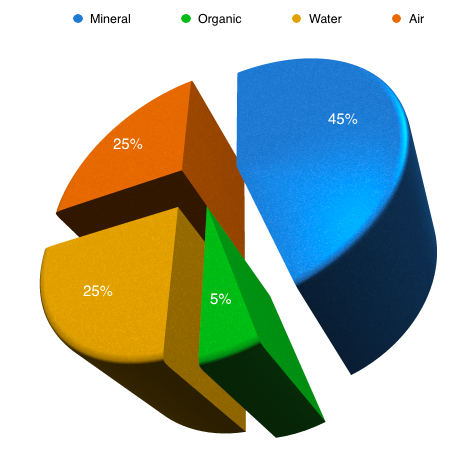
The pie chart above shows the ideal physical make up of the soil. What it shows is that 45% of the soil’s volume should be mineral matter (Sand, Silt and Clay) and around 5% should ideally be Organic Matter (Humus).
The relative proportions of the mineral and organic components dictates the soil’s Structure and Texture. Soil Structure defines how well the soil particles aggregate to create a stable medium for healthy plant growth and surface performance, but so far we’ve only accounted for 50% of the soil volume.
Incredibly the other 50% of the volume of the soil is just space! Well not just any space, but a split between Water and Air space. Water occupies small spaces between the soil particles called Micro-Pores, whilst Air occupies the large spaces called Macro-Pores. The relative amounts of Micro and Macro Porosity is dictated by the Soil’s texture.
Soil Texture is a measure of the relative proportions of Sand, Silt and Clay that make up the mineral component of the soil. Soil Texture is defined and categorised according to the Soil Texture Triangle.

Each of the different coloured segments in the triangle is called a Soil Textural Class and the ideal sector for the optimum performance in a bowling green is the Sandy Loam segment. The soil textural class of your rootzone influences a whole range of Chemical and Physical processes in your green.
Drainage is an obvious process that is dictated by soil texture. When the soil has a high sand content, it will drain quickly, but if there is too much sand then it might drain too quickly and be unable to provide enough moisture to the plants. I call the point at which the soil starts to become too sandy Peak Sand.
Soils that are beyond Peak Sand are usually lacking in clay and humus, meaning that they can’t hold on to sufficient moisture or nutrition to keep the turf healthy.
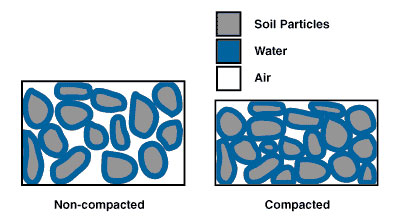
Soil’s that don’t have enough sand can become easily compacted, meaning that drainage is impeded, as are many biological functions in the soil. This process is called Compaction and it simply means that the soil particles are more readily squeezed together by the weight of foot and maintenance traffic. When the soil is compacted, Macro Porosity suffers with the resulting slow down in the drainage capacity of the soil. Another negative effect is that there is less room for Air in the soil making it become anaerobic (lacking Oxygen) and this negatively impacts the Soil’s Biology.
Soil Biology
Biology deals with living organisms and in a healthy bowling green there are a great many of them ranging from the grasses we aim to grow (along with the odd weed and moss from time to time), worms, insects and a massive range of micro-organisms grouped into types such as Bacteria, Fungi, Nematodes and Protozoa. In a teaspoonful of healthy, thriving soil there will be 1 Billion of these microscopic organisms and every one of them has a role to play in the soil/turf eco-system.
Beneath our feet, there is the most remarkable factory where fertiliser for our turf is essentially produced for free, but only if the soil is working properly. In simple terms bacteria eat the proteins, sugars and carbohydrates that leak from the roots of the plants. Fungi mop up any juice exuded by the roots that they can, but most live on the more woody cellulose and lignin found in thatch. In turn, these bacteria and fungi become food themselves for predatory microbes including nematodes and protozoa. These predators excrete ammonium, which is then converted to nitrate by bacteria in the presence of oxygen. Nitrate can be used directly by the plants and so this amazing cycle of growth and decay continues, producing everything needed by the plants in terms of soil nutrients.
Mycorrhiza
One very important group of fungi that live in and around the roots of our fine grasses are called mycorrhizae, from the Latin via Greek for fungus (myco) and root (rhiza). Mycorrhizal fungi associate with the root systems of our perennial grasses and together they form a symbiotic relationship where the Mycorrhizal fungi extend their hyphae into the soil, produce enzymes that make phosphate and other nutrients available to the plant and then transfer these nutrients, trace elements and water back to the plant in a form it can readily use to supply the raw ingredients for growth. We can think of these fungi as something akin to a root extension as they extend the effective root area of the plant many times over, allowing it to access resources from a far greater volume of soil than it otherwise would be able to.
This relationship makes perennial grasses (bent and fescue) twice as efficient as annuals, which rely on fertiliser inputs to grow. Of course, this seemingly miraculous symbiotic activity goes on in natural grassland systems and closer to home, in areas such as meadows and even golf course roughs without fertiliser inputs and without thatch building up!
The Circle of Decline
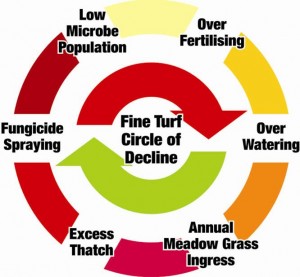
One of the major themes of Bowls Central over the years has been to expose the endless cycle of negative impacts on bowling greens due to a phenomenon I’ve called The Circle of Decline.
Excessive use of sand takes greens beyond Peak Sand, making them inert and lifeless and only capable of sustaining annual grasses like Poa annua. To do this we need to add ever more mineral fertiliser to achieve a half way decent growth response. This amount of synthetic fertiliser and the shallow rooted meadow grass need more water than usual, so we irrigate more to keep the system going. When we do that we close down air space in the soil causing it to become increasingly anaerobic. The soil becomes acidic and this increasingly hostile environment leads to rapid thatch accumulation at the surface as beneficial soil microbes such as thatch eating fungi are missing or only sticking around in very small numbers. Thatch breeds fungal diseases, contributes to disorders like Localised Dry Patch (LDP) and generally disrupts the playing surface. Of course, this leads to the routine use of turf fungicides which ensure that beneficial fungi have no chance of recovering too.
Thatch
This continuing cycle of events is the Circle of Decline in action and regardless of the agronomic damage, the disruption to play is the most important aspect for greenkeepers.
Thatch build up is one of the most devastating features of this cycle and it kills green performance in 3 main ways.
Thatch and Green Speed
 Due to the spongy, soft nature of an excessive thatch layer, the energy needed to propel a bowl a set distance is increased significantly. The fibrous mat of thatch actually saps the energy from your shots making it difficult to play with any level of finesse or predictability. It essentially produces a surface that is unfairly inconsistent. It’s a bit like playing on deep pile carpet, but more tricky.
Due to the spongy, soft nature of an excessive thatch layer, the energy needed to propel a bowl a set distance is increased significantly. The fibrous mat of thatch actually saps the energy from your shots making it difficult to play with any level of finesse or predictability. It essentially produces a surface that is unfairly inconsistent. It’s a bit like playing on deep pile carpet, but more tricky.
Thatch and Green Trueness
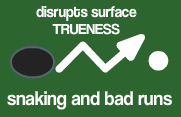 Excessive thatch build up has a tendency to dry out unevenly, leaving dips and bumps on the green surface that will cause a bowl to veer off it’s course unexpectedly. The nature of thatch means that even if you could get a handle on this and play accordingly in your match, it will all be different tomorrow. Thatch is continually moving, shrinking and expanding in response to the environmental changes in air temperature, soil temperature and moisture, weather and relative humidity.
Excessive thatch build up has a tendency to dry out unevenly, leaving dips and bumps on the green surface that will cause a bowl to veer off it’s course unexpectedly. The nature of thatch means that even if you could get a handle on this and play accordingly in your match, it will all be different tomorrow. Thatch is continually moving, shrinking and expanding in response to the environmental changes in air temperature, soil temperature and moisture, weather and relative humidity.
Thatch is the main cause of complaints about straight hands, bad runs and dodgy rinks.
Thatch and Green Smoothness
 Almost imperceptible dips, hollows, bumps and gullies in the surface which move and change continually with weather and moisture changes are features of excessive thatch. Of course this can cause quite a lot of disruption to your shot as it traverses the rink.
Almost imperceptible dips, hollows, bumps and gullies in the surface which move and change continually with weather and moisture changes are features of excessive thatch. Of course this can cause quite a lot of disruption to your shot as it traverses the rink.
In addition to the sapping of speed and deviations in the direction of the shot, thatch causes vertical deviation of the shot due to bumpiness on the green surface.
Hitting the Sweet Spot with Your Greenkeeping
When Greenkeeping is laid out like this you could start to get the feeling that it’s impossibly complicated to get it right, but the opposite is actually the case.
In a recent article I mentioned Do Nothing Greenkeeping and the fact is, if we had all been doing a lot less greenkeeping (in terms of applying fungicides, sand and high salt fertilisers) over the last 3 or 4 decades many more bowling greens would be in better shape and performing to a much higher standard already.
It is entirely possible that you can get your green into the Sweet Spot where Chemistry, Physics and Biology are perfectly balanced and it’s nowhere near as difficult as you might think. Into the bargain, it will save your club money in the long run and help you produce a consistently high performance bowling surface.
Concentrate on the Biology
You might have problems in your soil Chemistry like low pH or poor CEC, and although you might also have Physical problems like a Soil Texture that has been pushed beyond Peak Sand by too much annual sand top dressing, the answer to all of these problems is to concentrate on improving the Soil Biology. This is where you will get the most bang for your buck. As you improve the soil’s biological make up, you will naturally correct or compensate for some of the worst Physical and Chemical problems too, bringing the whole system closer to the sweet spot we are aiming for.
From my previous articles on the Circle of Decline you will know that there is no good or bad time to start making inroads to turn the situation around. However, starting the process calls for a different approach depending on the time of year. In the summer months when the soil temperature is up and the turf is growing actively.
Quick Start Biology boost
To get closer to the sweet spot this summer and get off to a flying start in boosting your soil’s biology you need to make hay while the sun shines. This intensive little program will help you to make a giant leap forward over the next 3 or 4 months. Follow one or other of the plans below, depending on the level of thatch you have.
Sarrell Rolling
This is an excellent way to keep the surface open to allow your spray applications into the soil without disrupting play.
Pencil Tining
For deep thatch layers, at least one run with longer tines will be necessary in order to make sure there is enough Oxygen getting to the roots and thatch layer to encourage the soil microbes to get working fast.
Thatch Eater
Thatch Eater is a cocktail of beneficial soil fungi and bacteria specially selected for their ability to rapidly degrade thatch and organic matter and to release locked-up nutrients for plant growth, converting it to humus. The bacteria and fungi are centrifuge-dried into a zeolite carrier to enhance their metabolism and to protect them from ultra violet light and chemicals.
FORMULA GREEN
Formula Green contains a powerful blend of Trace Elements complexed with carbohydrates and humates, Liquid Seaweed, Molasses, Amino Acids, Humic and Fulvic Acids.
LIQUID NK, with seaweed and humates
LIQUID NK provides an excellent source of plant Nitrogen, promotes the soil food web and mineralisation, without causing excessive soft growth.
Mycorrhizal Turf Root Developer
Turf Root Developer Stimulates and promotes root growth increasing root mass, enhances nutrient uptake, increases plant tolerance to drought and stress conditions provides an ideal solution for populating root zone soils and establishing beneficial biological activity.
Checking Where You Are!
If you have a Thatch layer on your green of more than 10mm, then you can safely and productively apply one of the above programs now.
However, to get a clearer picture of where your green in terms of Soil Chemistry and Physics and to measure progress I recommend that you order a full soil analysis to let you see exactly what the underlying conditions are.
I will personally write a comprehensive report and suggested greenkeeping program specifically for your green to accompany your soil analysis results.

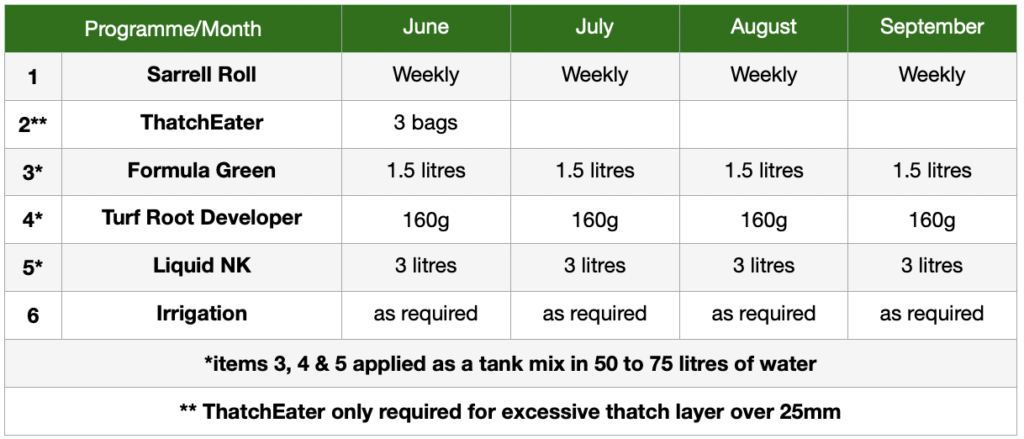


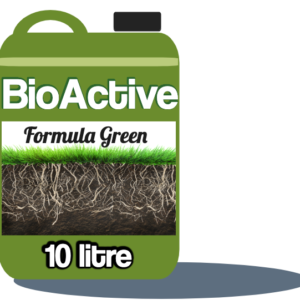
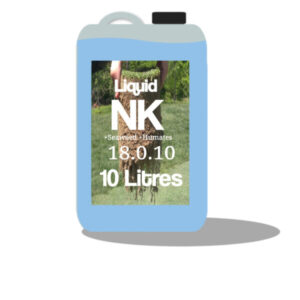
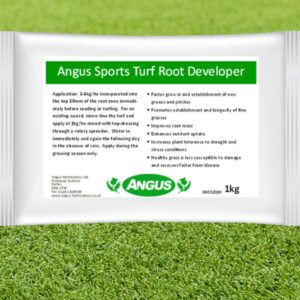
John,
We are now starting to mow 3 times a week. We are also spraying compost tea and other additives on a regular basis.
What are your thoughts on the intervals between spraying and mowing?
Regards
John W.
Hi John
If you spray as a soil drench (as per guides/programme) after mowing or on in between mowing days, all should be fine
Regards
John